According to WHO experts, psoriasis is a disease that affects 2 to 4% of the world population. A feature of this disease is that only representatives of the Caucasian race get psoriasis. Determining the cause and treating psoriasis is considered one of the priority tasks of modern medicine. Today science has advanced far in these matters, but the cause of the disease is still not fully understood, nor has a complete cure for this disease been found.

Causes of Psoriasis
Physiologically, psoriasis is caused by the short life cycle of skin cells. If this cycle normally lasts from 21 to 28 days, in patients with psoriasis the cycle only lasts from 3 to 6 days. This is what causes psoriasis plaques to form. The reason for this phenomenon is mainly debated among specialists. While some consider psoriasis to be a genetic disease, others believe it is caused by a malfunction in the immune system, which is a direct result of a whole host of external factors. different.
Today, among doctors, the multifactorial theory prevails, which explains the occurrence of psoriasis for the following reasons:
- Heredity;
- The immune system malfunctions due to:
- Postponing infectious diseases;
- Inappropriate nutrition;
- Alcohol abuse;
- Climatic conditions are not favorable.
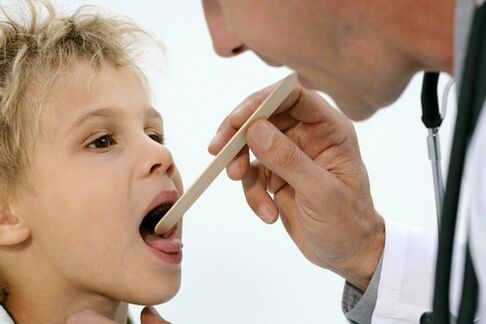
However, absolutely all experts agree on one thing, psoriasis is not an infectious disease and cannot be "caught" on the street like a cold or a sore throat.
Symptoms of Psoriasis
Today, doctors consider psoriasis to be a systemic disease, that is, it is often said that psoriasis is a disease with many complex effects.
It is believed that the first signs of the development of psoriasis are:
- A general feeling of weakness often;
- Feeling tired;
- Frequent depression and depression.
These symptoms should be alarming. However, clinical symptoms of psoriasis are manifested in lesions on the skin. In the case of psoriasis, often patches of psoriasis appear suddenly on the patient's body. They may be small at first (a few millimeters), but over time they can grow significantly (up to 10 cm in diameter).
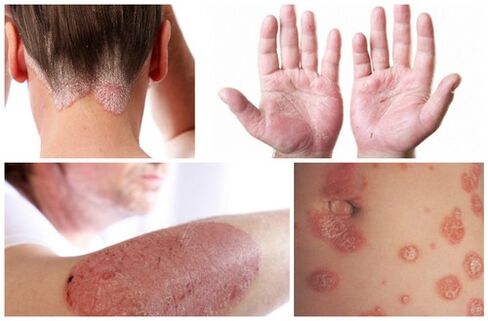
According to the nature of the rash, psoriasis is usually divided into:
- Spot (diameter of the small patch, not exceeding the diameter of the tip of the match);
- Drops, about the size of a lentil, but dropsy;
- Round, coin-shaped plaques, reminiscent of a coin up to 5 mm in diameter.
Psoriasis is characterized by the formation of scales on each patch, which is very easy to peel off. This is due to the fact that they are formed by the cells of the stratified epidermis. Scales are formed first in the center of the plaque, and then spread to the edges. Sometimes a pink ring forms around the plaque, which indicates growth of the plaque itself. When the scab peels off, the smooth, shiny skin remains, which is pink due to the proximity of the blood vessels (capillaries) together.
Classification of psoriasis, what psoriasis looks like (photo)
In most cases, doctors deal with common (vulgar) psoriasis. However, in about 10% of cases, the manifestation of psoriasis has other external signs, which are clearly visible in the photo.
According to the external manifestations of psoriasis, it is customary to distinguish the following forms:
- Vulgar (common) psoriasis. It begins with a rash of small papules the size of a matchstick to a pea. These papules occur scaly and the papules turn into typical psoriatic plaques. As a rule, the patches have clear boundaries, allowing them to be clearly visualized in relation to healthy skin. The plaques can cause itching. If the patient tries to remove the papilloma or plaque, scabs will be seen. After the scab is removed, the smooth surface is exposed. If you continue the shaving process, drops of blood appear very quickly, the so-called "blood mist";
- Erythema psoriatic. This, an extremely unpleasant disease like a form of psoriasis, occurs in about 2% of people with the condition. Erythroderma manifests itself in the form of severe itching, diffuse redness of the skin, as well as patchy peeling. Typically, psoriatic erythema is associated with systemic pustular psoriasis and psoriatic arthritis. Often, infections such as streptococcal infections further complicate the course of the disease. Sometimes erythroderma manifests itself spontaneously in the early stages of psoriasis. In some cases, erythroderma develops due to improper treatment of psoriasis;
- Pustular psoriasis. This form of the disease is characterized by the formation of small, abscess-like pustules. With flow, this form of psoriasis can be generalized and localized. With localized form, pustules are localized in the area of the soles of the feet and palms. With a generalized form, the patient has an increase in body temperature and signs of body intoxication. This form of psoriasis is very dangerous, even fatal;
- Psoriatic arthritis. Many experts distinguish it as an independent autoimmune disease. Appears in the form of an inflammatory process in the joints and muscles of the patient;
- Psoriasis of the nail plates. In some cases, common psoriasis affects the nail plates, and then they talk about psoriasis of the nails. Beating nail plaques from psoriasis is very similar to a fungal infection. As a result of the disease, the nails can become deformed and even disappear completely eventually.
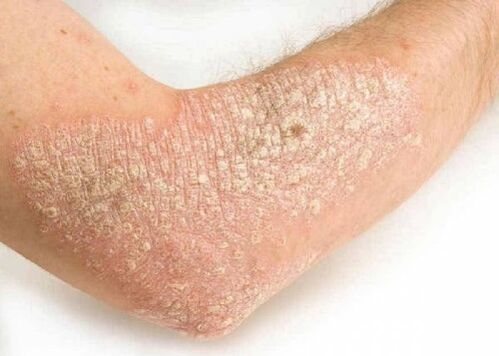
Treatment of psoriasis
Modern medicine still does not have at hand the means to completely cure psoriasis; There is still not enough knowledge about the causes and characteristics of the disease. However, in the arsenal of doctors there are several drugs that can significantly reduce the manifestations of psoriasis and transfer it from an acute phase to a long-term remission. When treating psoriasis, the doctor takes into account the patient's age, gender, lifestyle, health status, and only taking into account all these factors, when choosing a treatment strategy.
Very often, psoriasis treatment begins with external therapy. Including:
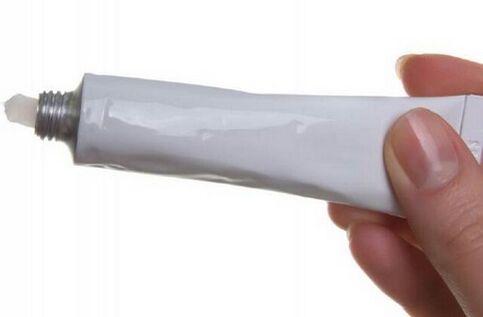
- Salicylic ointment, used at the time of disease progression;
- Hormonal drugs are prescribed if salicylic ointment does not work;
- Creams containing ditronal. They have anti-inflammatory effects and help get rid of psoriasis symptoms fairly quickly.
But external treatments do not always bring the desired results. Then, another treatment tactic is chosen, and the systematic approach is considered one of the most effective today.
Traditional medicine in the treatment of psoriasis
There are a large number of traditional medicine recipes for psoriasis. Many of them really help in the treatment of this disease. But do not overestimate the possibilities of such recipes, since traditional medicine can be used as an adjuvant therapy, but in no case as the main means of treatment.
Perhaps the most popular traditional medicine for psoriasis is celandine. Unfortunately, this method can only be treated in the summer, when it is not a problem to find celandine. The essence of the method lies in the action of the sap on the arrays. It is enough to simply break the stem and apply drops of the juice from the fracture to the psoriasis affected area. This should be done daily for three months. It is believed that the maximum therapeutic effect occurs during the third year of treatment.
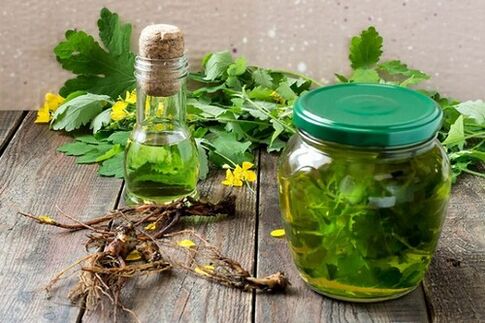
In second place in popularity is birch tar, which is simply spread over the affected surface for an hour. According to another method, after applying ringworm, celandine juice should be used. The course of treatment in the first case and in the second case is 15 days.
Egg-based ointments are considered very popular in the treatment of psoriasis. To prepare, take two raw eggs mixed with sunflower (olive) oil and beat. Then add half a teaspoon of vinegar to the resulting mixture. The affected areas are applied the mixture once a day. The mixture itself is stored in a dark and cool place.
It's great for psoriasis flare-ups and a bath with walnut shells added to it. For one bath, you need to incubate the shell from half a kilogram of nuts. Shower for no more than 15-20 minutes at a temperature not higher than 37 degrees. It is recommended to shower ten times with breaks in a day.
Diet for Psoriasis
According to many experts, proper nutrition in psoriasis patients is extremely important to avoid prolonging the disease's exacerbation. It is believed that the essence of the diet is to maintain an acid-base balance with respect to the alkaline component. So 70-80% of the product should be alkaline and only 20-25 acidifying.
Alkaline substances include:
- Fruit (except black cranberries and red grapes, prunes, plums and grapes);
- Vegetables (except beans, Brussels sprouts, squash, potatoes, tomatoes, peppers and eggplants).

Usually refers to acid forming products:
- Starch;
- Cheese;
- Street;
- Meat
- Butter;
- Cream.
Therefore, the diet of a patient with psoriasis should include:
- Water (at least 2 liters per day);
- Fresh, steamed fruit (canned fruit is undesirable). Apples, dates, figs, apricots, oranges, peaches, raisins are recommended;
- Vegetables, also fresh or steamed. It is recommended to use beets, cucumbers, lettuce, carrots, celery, spinach, zucchini, watercress, cabbage.
- Cereals (small quantity). Recommended are buckwheat, wheat, barley, millet porridge, as well as rice and cornmeal pies;
- Low-fat fish, four times a week;
- Poultry (chicken), two to three times a week. It is permissible to feed sick lambs once a week;
- Milk (skimmed is best);
- Soft-boiled eggs, two to three times a week;
- Vegetable oil at the rate of 3 teaspoons per day.

Preventive
And while there's no way to prevent psoriasis, there are ways to significantly reduce its manifestations and maximize the period of remission.
For this you need:
- Skin care and moisturizing;
- Excessive exposure to cold or hot air should be avoided;
- Minimize the possibility of damage to the skin surface;
- Give up alcohol and tobacco;
- All diseases are neurological, so you need to minimize the effects of stress and try to be attuned to yourself and the world around you.

























